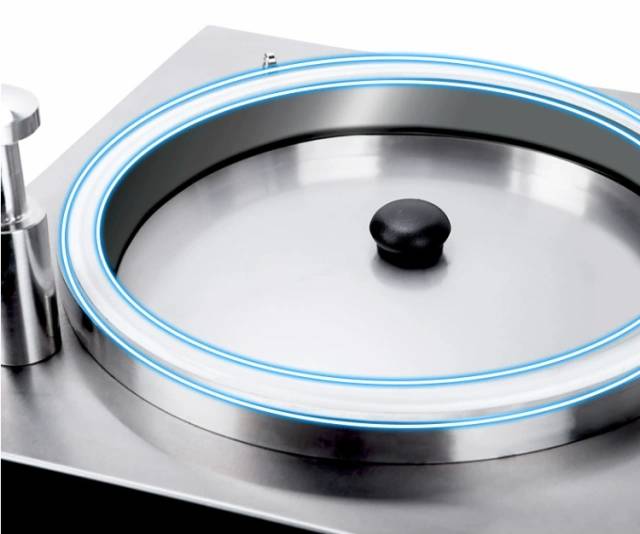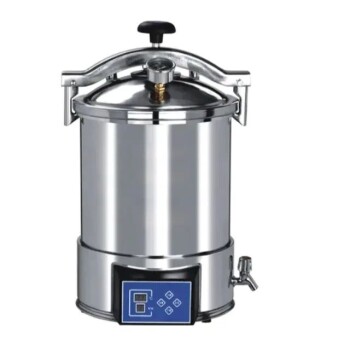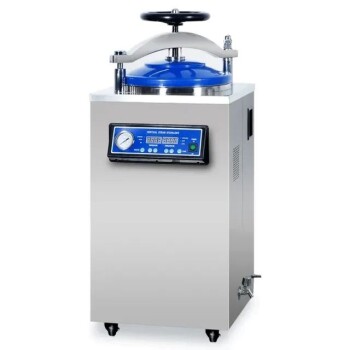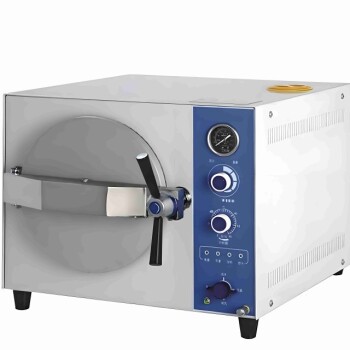
sterilization equipment
Laboratory Sterilizer Lab Autoclave Vertical Pressure Steam Sterilizer for Liquid Crystal Display Automatic Type
Item Number : KT-C04
Price varies based on specs and customizations
- Electric Tension
- 220V
- Working Temperature
- 134º C
Shipping:
Contact us to get shipping details Enjoy On-time Dispatch Guarantee.
Why Choose Us
Reliable PartnerEasy ordering process, quality products, and dedicated support for your business success.
Introduction
The vertical pressure steam sterilizer has the advantages of reliable sterilization effect, convenient operation, safe use, power saving and durable and cheap, etc. It is the ideal equipment for sterilization of surgical instruments, dressings, utensils, culture media, etc. in medical and health care, scientific research and other units.
Detail & Parts





Performance and Features
- High quality all stainless steel material
- Handwheel translation type quick opening structure
- safety interlock device
- LCD display working status, touch buttons
- Equipped with instrument sterilization program, dressing sterilization program, liquid sterilization program and custom program, so as to sterilize different types of items with suitable working temperature
- Automatic discharge of cold air, automatic discharge of steam after sterilization
- Over-temperature, over-pressure automatic protection function
- Water cut protection control
- self-expanding seal
- Buzzer reminds automatic shutdown after sterilization
- Simple operation, safe and reliable
- Equipped with stainless steel inner bucket or double-layer mesh basket
- Optional drying system
Technical Parameters
| Model | KT-35HD | KT-50HD | KT-75HD | KT-100HD |
| Sterilization chamber volume | 35L φ318×450mm | 50L φ340×550mm | 75L φ400×600mm | 100L φ440×650mm |
| Fixed work stress | 0.22Mpa | |||
| Rated working temperature | 134℃ | |||
| Work Pressure | 0.25Mpa | |||
| Thermal Uniformity | ≤±1℃ | |||
| Timing Selection Range | 0-99min/0-99hour59min | |||
| Temperature Selection Range | 1-134℃ | |||
| Power/supply voltage | 1 X 2.5KW/AC220V 50HZ | 2 X 2.5KW/AC220V 50HZ | 3 X 2.5KW/AC220V 50HZ | |
| Dimensions (mm) | 470×450×1020 | 520×490×1150 | 550×530×1180 | 580×560×1290 |
| Transport Volume (mm) | 540×540×1140 | 580×580×1250 | 610×610×1280 | 640×640×1360 |
| Gross weight/net weight | 81Kg/63Kg | 94Kg/74Kg | 113Kg/93Kg | 125Kg/105Kg |
Designed for You
KinTek provide deep custom made service and equipment to worldwide customers, our specialized teamwork and rich experienced engineers are capable to undertake the custom tailoring hardware and software equipment requirements, and help our customer to build up the exclusive and personalized equipment and solution!
Would you please drop your ideas to us, our engineers are ready for you now!
FAQ
What Is An Autoclave Sterilizer?
How Does An Autoclave Sterilizer Work?
What Are The Advantages Of Using Autoclave Sterilizers?
What Safety Precautions Should Be Taken When Using Autoclave Sterilizers?
Can All Materials And Items Be Sterilized Using Autoclave Sterilizers?
Are There Different Types Of Autoclave Sterilizers Available?
4.8
out of
5
The vertical pressure steam sterilizer is a lifesaver in our lab. It's so easy to use and sterilizes everything perfectly.
4.9
out of
5
This sterilizer is a real workhorse. It's been running non-stop in our lab for years and never fails us.
4.7
out of
5
I love the LCD display on this sterilizer. It makes it so easy to see the status of the sterilization cycle.
4.8
out of
5
The safety features on this sterilizer give me peace of mind. I know that my samples are safe and won't be contaminated.
4.9
out of
5
This sterilizer is worth every penny. It's saved us so much time and money in the long run.
4.7
out of
5
I'm so glad I bought this sterilizer. It's made my life so much easier.
4.9
out of
5
This sterilizer is a must-have for any lab. It's efficient, reliable, and easy to use.
4.8
out of
5
I highly recommend this sterilizer to anyone who needs a reliable and efficient way to sterilize their samples.
4.7
out of
5
This sterilizer is a great value for the price. It's well-made and does a great job of sterilizing my samples.
4.9
out of
5
I'm really impressed with this sterilizer. It's easy to use and does a great job of sterilizing my samples.
4.8
out of
5
This sterilizer is a great addition to our lab. It's made our work so much easier.
4.7
out of
5
I'm very happy with this sterilizer. It's reliable and does a great job of sterilizing my samples.
4.9
out of
5
This sterilizer is a great investment. It's saved us so much time and money.
4.7
out of
5
I'm really glad I bought this sterilizer. It's made my life so much easier.
REQUEST A QUOTE
Our professional team will reply to you within one business day. Please feel free to contact us!
Related Products

Portable Digital Display Automatic Laboratory Sterilizer Lab Autoclave for Sterilization Pressure
Portable autoclave sterilization pressure is a device that uses pressure saturated steam to quickly and effectively sterilize items.

Portable High Pressure Laboratory Autoclave Steam Sterilizer for Lab Use
Portable autoclave sterilization pressure is a device that uses pressure saturated steam to quickly and effectively sterilize items.

Laboratory High Pressure Steam Sterilizer Vertical Autoclave for Lab Department
Vertical pressure steam sterilizer is a kind of sterilization equipment with automatic control, which is composed of heating system, microcomputer control system and overheating and overpressure protection system.

Stainless High Pressure Autoclave Reactor Laboratory Pressure Reactor
Discover the versatility of Stainless High Pressure Reactor - a safe and reliable solution for direct and indirect heating. Built with stainless steel, it can withstand high temperatures and pressures. Learn more now.

Laboratory High Pressure Horizontal Autoclave Steam Sterilizer for Lab Use
The horizontal autoclave steam sterilizer adopts the gravity displacement method to remove the cold air in the inner chamber, so that the inner steam and cold air content is less, and the sterilization is more reliable.

Laboratory Horizontal Autoclave Steam Sterilizer Lab Microcomputer Sterilizer
The horizontal autoclave steam sterilizer adopts the method of gravity displacement to remove the cold air in the inner chamber, so that the content of steam cold air in the inner chamber is less, and the sterilization is more reliable.

Mini SS High Pressure Autoclave Reactor for Laboratory Use
Mini SS High Pressure Reactor - Ideal for medicine, chemical, and scientific research industries. Programmed heating temp and stirring speed, up to 22Mpa pressure.

Desktop Fast Laboratory Autoclave Sterilizer 20L 24L for Lab Use
The desktop fast steam sterilizer is a compact and reliable device used for rapid sterilization of medical, pharmaceutical, and research items.

Desktop Fast Laboratory Autoclave Sterilizer 35L 50L 90L for Lab Use
The desktop fast steam sterilizer is a compact and reliable device used for rapid sterilization of medical, pharmaceutical, and research items. It efficiently sterilizes surgical instruments, glassware, medicines, and resistant materials, making it suitable for various applications.

Laboratory Sterilizer Lab Autoclave Pulsating Vacuum Desktop Steam Sterilizer
The pulsating vacuum desktop steam sterilizer is a compact and reliable device used for rapid sterilization of medical, pharmaceutical, and research items.

Laboratory Sterilizer Lab Autoclave Pulse Vacuum Lifting Sterilizer
The pulse vacuum lifting sterilizer is a state-of-the-art equipment for efficient and precise sterilization. It uses pulsating vacuum technology, customizable cycles, and a user-friendly design for easy operation and safety.

Desktop Fast High Pressure Laboratory Autoclave Sterilizer 16L 24L for Lab Use
The desktop fast steam sterilizer is a compact and reliable device used for rapid sterilization of medical, pharmaceutical, and research items.

Laboratory Sterilizer Lab Autoclave Herbal Powder Sterilization Machine for Plant
The herbal powder sterilization autoclave machine for Chinese medicine uses saturated steam for effective sterilization. It utilizes the heat and penetrative properties of steam, achieves sterilization after heat preservation, and maintains a good drying effect with a dedicated drying system.

High Pressure Laboratory Autoclave Reactor for Hydrothermal Synthesis
Discover the applications of Hydrothermal Synthesis Reactor - a small, corrosion-resistant reactor for chemical labs. Achieve rapid digestion of insoluble substances in a safe and reliable way. Learn more now.

Customizable High Pressure Reactors for Advanced Scientific and Industrial Applications
This laboratory-scale high-pressure reactor is a high-performance autoclave engineered for precision and safety in demanding research and development environments.

High Pressure Laboratory Vacuum Tube Furnace Quartz Tubular Furnace
KT-PTF High Pressure Tube Furnace: Compact split tube furnace with strong positive pressure resistance. Working temp up to 1100°C and pressure up to 15Mpa. Also works under controller atmosphere or high vacuum.

Anti-Cracking Press Mold for Lab Use
The anti-cracking press mold is a specialized equipment designed for molding various shapes and sizes of film using high pressure and electric heating.
Related Articles

Automatic flat plate heat press operating steps

Split isostatic pressing operation steps
Introduction to the steps of split isostatic pressing.

Laboratory Safety: High Pressure Equipment and Reactors
This article discusses safety measures and precautions for using high pressure equipment and reactors in laboratories, including case studies and detailed usage instructions.

Basic Cleaning and Disinfection Equipment in the Laboratory
Overview of essential lab cleaning and disinfection tools and their operational principles.

Application of Liquid Nitrogen in Food Freezing
Explores the use of liquid nitrogen in food freezing, its advantages, methods, equipment, and safety considerations.

The Real Reason Your Sintered Parts Crack (And It’s Not the Furnace)
Stop blaming the furnace. Discover the hidden flaw in powder pressing that causes parts to crack and learn how Cold Isostatic Pressing (CIP) offers a permanent fix.

Beyond Brute Force: The Physics and Psychology of Material Transformation
Explore the synergy of hydraulic pressure and thermal energy, and why precise control over both is the key to creating advanced materials.

Beyond Brute Force: How Isostatic Pressing Creates Flawless Materials
Explore isostatic pressing, a method using uniform pressure, not brute force, to eliminate microscopic flaws and achieve perfect material density.

Understanding Hot Isostatic Pressing in PVD Sputtering Targets
Explores the role of hot isostatic pressing in enhancing the quality and uniformity of PVD sputtering targets, focusing on manufacturing techniques and benefits.

Advanced International Plant Extraction Science and Technology
Exploring cutting-edge methods in essential oil extraction, including supercritical CO2, supramolecular, and targeted extraction techniques.

It’s Not a 'Bad Batch': Why Your High-Strength Rubber Parts Are Failing Prematurely
Frustrated by rubber components failing? The cause is rarely a 'bad batch.' Learn the real reason and how to select the right material every time.

Pressure & Precision: Mastering Material Integrity with Hot Press Technology
Explore the critical difference between hot press bonding (precision) and HIP (perfection). Learn how directional vs. isostatic pressure shapes material certainty.